Innovative Learning – And how they help drive business outcomes

Technology evolution in recent years together with the advent of digital commerce has brought in unprecedented change within businesses.
Responding to these disruptive influences requires that organisations know how to learn innovatively and develop proactive approaches that aid problem solving, continuous improvement and accelerate change. These offer solutions that work simpler, faster and continuously engage with customers. Recognising these benefits, many organisations are investing in innovative learning approaches such as social learning platforms and leveraging mobile learning solutions to drive collaborative and experiential learning at work.
Key Trends in Learning Innovation
Broadly, innovative learning within organisations is being managed across three key platforms. These include –
Mobile Learning – Mobile-based solutions such as learning apps are helping organisations deliver content more effectively – improving adoption, widening reach, and engaging learners better. Clarity on outcomes while executing their mobile strategy, as well as accessing the right technology partners, is helping them with minimising barriers to adoption.
Social Learning – Investing in social media tools and collaborative technologies help improve employee engagement and foster strong learning cultures. While there are multiple social tools available, many organisations struggle with requisite insights on these products and how they are effectively harnessed to drive learning. Social learning tools can be used beyond document sharing and discussion forums, and companies can migrate to videos and micro-blog formats to drive learning innovation.
Adaptive Learning – Adaptive learning tools help employees pace their learning. Unlike traditional learning models, the methodology aligns learning with the individual’s specific learning goals and offers approaches that are best suited to their needs. Adaptive learning allows for flexibility and interaction and is particularly useful in delivering learning to the newer generations of the workforce. Organisations using adaptive learning are more likely to experience improved employee engagement, work efficiencies and retention as employees find the space to build their confidence and work on developing their overall expertise.
Learning innovations drive business outcomes
In recent years, several organisations have adopted robust learning innovation approaches to drive key business outcomes.
MasterCard, a company that is at the forefront of innovations in the payments space, has built mature capabilities in product development and deployment of high-quality payment solutions, through its innovative learning strategy.
The company’s learning innovation approach has helped drive strong capability in product management excellence and included the adoption of a highly disciplined and meticulous delivery approach that draws from product knowledge and insights across regional and global leaders.
While being intense and global, the learning curriculum was flexible enough to recognise and cater to local and regional differences and included several learning alternatives, such as
- Multiple e-learning programs with access to global SMEs to aid regional and local focus on product knowledge.
- Technology platforms that support multi-faceted content including product-specific resources, workbooks, presentations and case studies, and learning assessments.
The company also launched Connected Learning – an innovative learning engine which delivers resources in line with time-sensitive business needs and enables content that is specific and relevant to everyday roles and functional responsibilities. With the flexibility to connect several learning groups and globally collaborative teams, the engine has enabled across the board participation in design, customisation and deployment of product tools.
Succeeding with Learning Innovation
As in the case of MasterCard, learning innovation can be an intense and transformative process – and organisations will need to plan and adopt specific measures to ensure the desired business outcomes.
Here are some quick steps to keep you on the path –
Align learning to business objectives
Ensure your learning professionals are aligned with the needs of the business and are constantly interacting with managers to understand their goals and deliverables. This will help align content design and learning investments with business outcomes and drive greater engagement and performance.
Reach out to the right providers
Work with providers who offer innovative learning capabilities on mobile and social platforms. Ensure that they design and deliver learning programmes that can be easily aligned with a variety of learning needs to enable meaningful delivery and impact. It is also essential that they design tools that are easily customised and can deliver across multiple contexts.
The right metrics matter
Innovative learning strategies can deliver the desired business outcomes only within organisations that foster strong metrics. It’s, therefore, essential that a strong metrics approach is in place, and importantly, knowing what it needs to measure. For instance, the success of learning interventions is usually measured through changes to employee engagement, morale, etc. While these are important, measuring changes in employee attrition and retention levels, and revenue per employee can offer insightful business metrics.
Remember to keep it simple and flexible
Learning innovations are empowering employees across organisations to derive knowledge across multiple learning formats, connect and share ideas, and gain insights to drive strong business outcomes. Simplified and innovative learning when combined with flexible design and delivery approaches can help organisations drive real business impact.
Innovative Learning – And how they help drive business outcomes

Technology evolution in recent years together with the advent of digital commerce has brought in unprecedented change within businesses.
Responding to these disruptive influences requires that organisations know how to learn innovatively and develop proactive approaches that aid problem solving, continuous improvement and accelerate change. These offer solutions that work simpler, faster and continuously engage with customers. Recognising these benefits, many organisations are investing in innovative learning approaches such as social learning platforms and leveraging mobile learning solutions to drive collaborative and experiential learning at work.
Key Trends in Learning Innovation
Broadly, innovative learning within organisations is being managed across three key platforms. These include –
Mobile Learning – Mobile-based solutions such as learning apps are helping organisations deliver content more effectively – improving adoption, widening reach, and engaging learners better. Clarity on outcomes while executing their mobile strategy, as well as accessing the right technology partners, is helping them with minimising barriers to adoption.
Social Learning – Investing in social media tools and collaborative technologies help improve employee engagement and foster strong learning cultures. While there are multiple social tools available, many organisations struggle with requisite insights on these products and how they are effectively harnessed to drive learning. Social learning tools can be used beyond document sharing and discussion forums, and companies can migrate to videos and micro-blog formats to drive learning innovation.
Adaptive Learning – Adaptive learning tools help employees pace their learning. Unlike traditional learning models, the methodology aligns learning with the individual’s specific learning goals and offers approaches that are best suited to their needs. Adaptive learning allows for flexibility and interaction and is particularly useful in delivering learning to the newer generations of the workforce. Organisations using adaptive learning are more likely to experience improved employee engagement, work efficiencies and retention as employees find the space to build their confidence and work on developing their overall expertise.
Learning innovations drive business outcomes
In recent years, several organisations have adopted robust learning innovation approaches to drive key business outcomes.
MasterCard, a company that is at the forefront of innovations in the payments space, has built mature capabilities in product development and deployment of high-quality payment solutions, through its innovative learning strategy.
The company’s learning innovation approach has helped drive strong capability in product management excellence and included the adoption of a highly disciplined and meticulous delivery approach that draws from product knowledge and insights across regional and global leaders.
While being intense and global, the learning curriculum was flexible enough to recognise and cater to local and regional differences and included several learning alternatives, such as
- Multiple e-learning programs with access to global SMEs to aid regional and local focus on product knowledge.
- Technology platforms that support multi-faceted content including product-specific resources, workbooks, presentations and case studies, and learning assessments.
The company also launched Connected Learning – an innovative learning engine which delivers resources in line with time-sensitive business needs and enables content that is specific and relevant to everyday roles and functional responsibilities. With the flexibility to connect several learning groups and globally collaborative teams, the engine has enabled across the board participation in design, customisation and deployment of product tools.
Succeeding with Learning Innovation
As in the case of MasterCard, learning innovation can be an intense and transformative process – and organisations will need to plan and adopt specific measures to ensure the desired business outcomes.
Here are some quick steps to keep you on the path –
Align learning to business objectives
Ensure your learning professionals are aligned with the needs of the business and are constantly interacting with managers to understand their goals and deliverables. This will help align content design and learning investments with business outcomes and drive greater engagement and performance.
Reach out to the right providers
Work with providers who offer innovative learning capabilities on mobile and social platforms. Ensure that they design and deliver learning programmes that can be easily aligned with a variety of learning needs to enable meaningful delivery and impact. It is also essential that they design tools that are easily customised and can deliver across multiple contexts.
The right metrics matter
Innovative learning strategies can deliver the desired business outcomes only within organisations that foster strong metrics. It’s, therefore, essential that a strong metrics approach is in place, and importantly, knowing what it needs to measure. For instance, the success of learning interventions is usually measured through changes to employee engagement, morale, etc. While these are important, measuring changes in employee attrition and retention levels, and revenue per employee can offer insightful business metrics.
Remember to keep it simple and flexible
Learning innovations are empowering employees across organisations to derive knowledge across multiple learning formats, connect and share ideas, and gain insights to drive strong business outcomes. Simplified and innovative learning when combined with flexible design and delivery approaches can help organisations drive real business impact.




